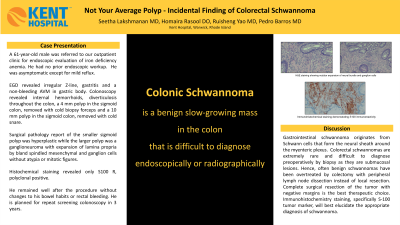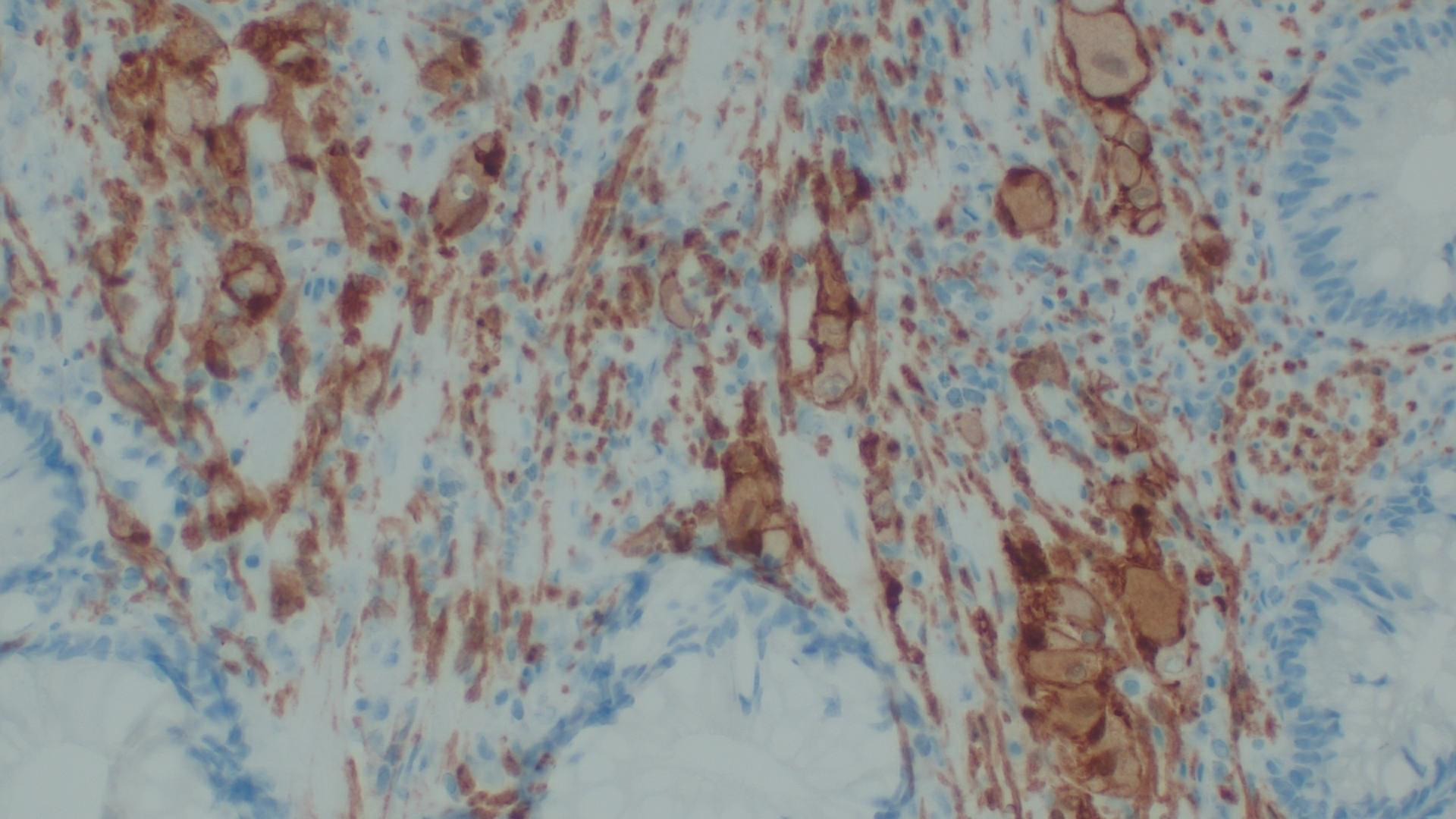Tuesday Poster Session
Category: Colon
P3139 - Not Your Average Polyp - Incidental Finding of Colorectal Schwannoma
Tuesday, October 24, 2023
10:30 AM - 4:00 PM PT
Location: Exhibit Hall

Has Audio

Seetha Lakshmanan, MD
Kent Hospital
Cumberland, RI
Presenting Author(s)
Seetha Lakshmanan, MD1, Homaira Rasool, DO2, Ruisheng Yao, MD2, Pedro Barros, MD2
1Kent Hospital, Cumberland, RI; 2Kent Hospital, Warwick, RI
Introduction: Schwannomas are nerve sheath tumors that can occur anywhere along the peripheral nerves. They are a slow-growing mass and 96.9% of them are considered benign, thus, adequate minimally invasive surgery should be considered when removing them. Owing to the absence of any distinctive features, gastrointestinal schwannomas are difficult to diagnose endoscopically or radiographically. We present a case of colonic schwannoma in an asymptomatic patient identified during surveillance colonoscopy.
Case Description/Methods: A 61-year-old male was referred to our outpatient clinic for endoscopic evaluation of his iron deficiency anemia. He had no prior endoscopic workup. He was asymptomatic except for mild reflux. EGD revealed irregular Z-line, gastritis and a nonbleeding AVM in the gastric body. Colonoscopy revealed internal hemorrhoids, diverticulosis throughout the colon, a 4 mm polyp in the sigmoid colon, removed with cold biopsy forceps and a 10 mm polyp in the sigmoid colon, removed with cold snare. Surgical pathology report of the smaller sigmoid polyp was hyperplastic while the larger polyp was a ganglioneuroma with expansion of lamina propria by bland spindled mesenchymal and ganglion cells without atypia or mitotic figures. Histochemical staining revealed only S100 R, polyclonal positive. He remained well after the procedure without changes to his bowel habits or rectal bleeding. He is planned for repeat screening colonoscopy in 3 years.
Discussion: Gastrointestinal schwannoma originates from Schwann cells that form the neural sheath around the myenteric plexus. Colorectal schwannomas are extremely rare and difficult to diagnose preoperatively by biopsy as they are submucosal lesions. Hence, often benign schwannomas have been overtreated by colectomy with peripheral lymph node dissection instead of local resection. Complete surgical resection of the tumor with negative margins is the best therapeutic choice in these cases. Immunohistochemistry staining, specifically S-100 tumor marker, will best elucidate the appropriate diagnosis of schwannoma.

Disclosures:
Seetha Lakshmanan, MD1, Homaira Rasool, DO2, Ruisheng Yao, MD2, Pedro Barros, MD2. P3139 - Not Your Average Polyp - Incidental Finding of Colorectal Schwannoma, ACG 2023 Annual Scientific Meeting Abstracts. Vancouver, BC, Canada: American College of Gastroenterology.
1Kent Hospital, Cumberland, RI; 2Kent Hospital, Warwick, RI
Introduction: Schwannomas are nerve sheath tumors that can occur anywhere along the peripheral nerves. They are a slow-growing mass and 96.9% of them are considered benign, thus, adequate minimally invasive surgery should be considered when removing them. Owing to the absence of any distinctive features, gastrointestinal schwannomas are difficult to diagnose endoscopically or radiographically. We present a case of colonic schwannoma in an asymptomatic patient identified during surveillance colonoscopy.
Case Description/Methods: A 61-year-old male was referred to our outpatient clinic for endoscopic evaluation of his iron deficiency anemia. He had no prior endoscopic workup. He was asymptomatic except for mild reflux. EGD revealed irregular Z-line, gastritis and a nonbleeding AVM in the gastric body. Colonoscopy revealed internal hemorrhoids, diverticulosis throughout the colon, a 4 mm polyp in the sigmoid colon, removed with cold biopsy forceps and a 10 mm polyp in the sigmoid colon, removed with cold snare. Surgical pathology report of the smaller sigmoid polyp was hyperplastic while the larger polyp was a ganglioneuroma with expansion of lamina propria by bland spindled mesenchymal and ganglion cells without atypia or mitotic figures. Histochemical staining revealed only S100 R, polyclonal positive. He remained well after the procedure without changes to his bowel habits or rectal bleeding. He is planned for repeat screening colonoscopy in 3 years.
Discussion: Gastrointestinal schwannoma originates from Schwann cells that form the neural sheath around the myenteric plexus. Colorectal schwannomas are extremely rare and difficult to diagnose preoperatively by biopsy as they are submucosal lesions. Hence, often benign schwannomas have been overtreated by colectomy with peripheral lymph node dissection instead of local resection. Complete surgical resection of the tumor with negative margins is the best therapeutic choice in these cases. Immunohistochemistry staining, specifically S-100 tumor marker, will best elucidate the appropriate diagnosis of schwannoma.

Figure: Immunohistochemical staining demonstrating S100 immunoreactivity
Disclosures:
Seetha Lakshmanan indicated no relevant financial relationships.
Homaira Rasool indicated no relevant financial relationships.
Ruisheng Yao indicated no relevant financial relationships.
Pedro Barros indicated no relevant financial relationships.
Seetha Lakshmanan, MD1, Homaira Rasool, DO2, Ruisheng Yao, MD2, Pedro Barros, MD2. P3139 - Not Your Average Polyp - Incidental Finding of Colorectal Schwannoma, ACG 2023 Annual Scientific Meeting Abstracts. Vancouver, BC, Canada: American College of Gastroenterology.
